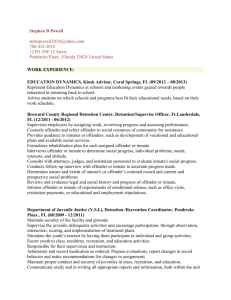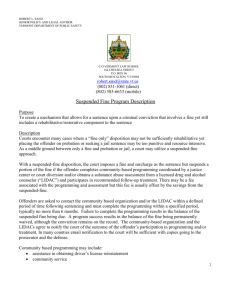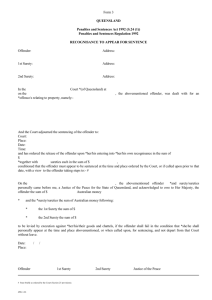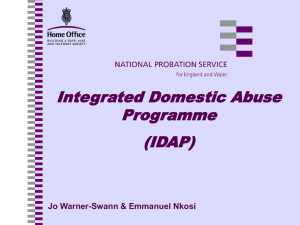FULL WRITTEN PRE-SENTENCE REPORT
advertisement
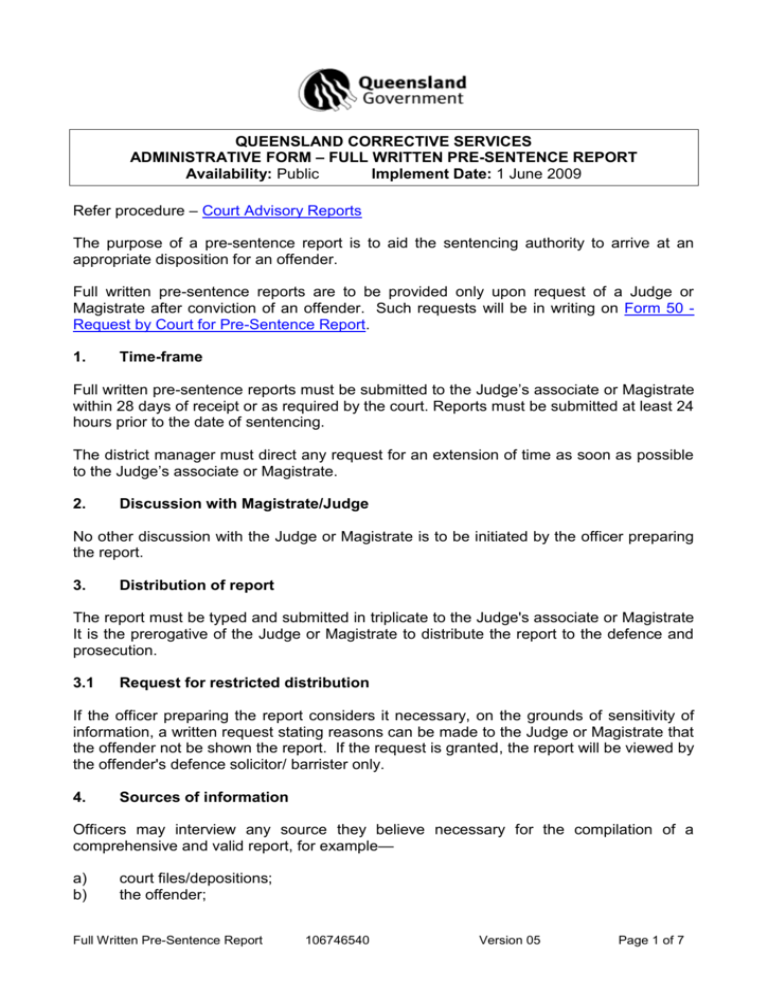
QUEENSLAND CORRECTIVE SERVICES ADMINISTRATIVE FORM – FULL WRITTEN PRE-SENTENCE REPORT Availability: Public Implement Date: 1 June 2009 Refer procedure – Court Advisory Reports The purpose of a pre-sentence report is to aid the sentencing authority to arrive at an appropriate disposition for an offender. Full written pre-sentence reports are to be provided only upon request of a Judge or Magistrate after conviction of an offender. Such requests will be in writing on Form 50 Request by Court for Pre-Sentence Report. 1. Time-frame Full written pre-sentence reports must be submitted to the Judge’s associate or Magistrate within 28 days of receipt or as required by the court. Reports must be submitted at least 24 hours prior to the date of sentencing. The district manager must direct any request for an extension of time as soon as possible to the Judge’s associate or Magistrate. 2. Discussion with Magistrate/Judge No other discussion with the Judge or Magistrate is to be initiated by the officer preparing the report. 3. Distribution of report The report must be typed and submitted in triplicate to the Judge's associate or Magistrate It is the prerogative of the Judge or Magistrate to distribute the report to the defence and prosecution. 3.1 Request for restricted distribution If the officer preparing the report considers it necessary, on the grounds of sensitivity of information, a written request stating reasons can be made to the Judge or Magistrate that the offender not be shown the report. If the request is granted, the report will be viewed by the offender's defence solicitor/ barrister only. 4. Sources of information Officers may interview any source they believe necessary for the compilation of a comprehensive and valid report, for example— a) b) court files/depositions; the offender; Full Written Pre-Sentence Report 106746540 Version 05 Page 1 of 7 c) d) e) f) g) h) i) relatives of the offender (eg spouses, parents); employers of the offender; arresting officer; previous reports/service files; other agencies who have had contact with the offender; friends of the offender; and the victim (in certain circumstances). Victims of offences should not be interviewed unless they would normally be sources of information (eg an employer who was embezzled by the offender or a spouse who had been assaulted). Refer to the district manager in all other circumstances. Refer to QP9's (Police briefs of evidence) and court depositions for the description of the offence in the report. It should be stated if the offender's version varies significantly from the official version. 5. Verification of information Officers may be cross-examined on the content of the pre-sentence report. To this end, officers should ensure that all information provided as fact in the report is verified. 6. Legal acceptability of information Charges, acquittals, alleged offences, voluntary and third party disclosures of offences for which the offender has not been convicted should not be included. Recognizance under s 558 of the Crimes Act 1900 (NSW) and juvenile offences (Juvenile Justice Act 1992) actually recorded as "convictions" in Queensland may be included. There should be no opinion in the report about the guilt or innocence of the offender, as the conviction has already been incurred. 7. Content See below for report format and content instructions. 8. Request by judiciary for a medical/psychiatric or psychological report A Judge or Magistrate may require a medical/psychiatric or psychological report in conjunction with a pre-sentence report. The request will be made on a Form 50 - Request by Court for Pre-Sentence Report. A probation and parole officer does not prepare this report, however the officer acts as a referral and co-ordination service to facilitate access to the report. This service is provided as a matter of goodwill to the Department of Justice and Attorney-General. 8.1. Referring offender When an officer receives a Form 50 - Request by Court for Pre-Sentence Report requesting a medical/psychiatric report, the officer should— a) if the offender is on bail, make an immediate appointment with a provider of psychiatric services used by the particular area office; or Full Written Pre-Sentence Report 106746540 Version 05 Page 2 of 7 b) if the offender is in custody, make a referral to a provider of psychiatric services close to where the offender is being held. Referral documentation should include— a) b) c) d) e) name of the Judge/Magistrate requiring the report; date required; address to which to send the report; the official version of the offence (QP9 or court depositions available from the prosecutor) and an up-to-date criminal history; and a social history of the offender, including any past contact with Queensland Corrective Services, and any relevant previous reports. The Department of Justice and Attorney-General is responsible for costs of these reports. The agency providing the report should be instructed to forward an account directly to the court requesting the report. If a psychiatric or psychological report is requested by a court but not in conjunction with a pre-sentence report, the registrar of the court requesting the report is responsible for the referral and co-ordination of the report and all associated costs. 10. Child Sex Offenders When preparing a pre-sentence report on any child sex offender, it may be beneficial to conduct a home assessment to ascertain if there are any identifiable risks. The home assessment must ascertain if the premises is suitable (discussed below). A recommendation may be made to the court that an additional requirement be added to the proposed order to ensure the offender only resides at premises considered suitable by the offender’s supervising officer. An example of suitable wording (as adopted by the Supreme Court) would be— “Reside at a place as approved by a corrective services officer by way of a suitability assessment. The place is not within close proximity of a school or other public place or business where children are cared for or supervised”.. Generally, an address is unsuitable if it is— a) b) c) within close proximity of a school or other public place or business where children are cared for or supervised; occupied or frequently visited by unsupervised children other than the offender’s biological children; or a caravan park or other accommodation with shared bathroom facilities commonly utilised by children. A recommendation should be made to the court to include additional requirements to empower a supervising officer to adequately monitor employment. An example of suitable wording (as adopted by the Supreme Court) would be— “Not obtain or maintain employment that includes the supervision of children, where the majority of customers are children, that allows ready access to children or regular communication with children. Full Written Pre-Sentence Report 106746540 Version 05 Page 3 of 7 Notify the supervising corrective services officer of the nature of his/her employment, the hours of work each day, the name of his employer and the address of the premises where he is employed”. Full Written Pre-Sentence Report 106746540 Version 05 Page 4 of 7 Notes PRE-SENTENCE REPORT The pre-sentence report contains information to assist courts in sentencing. In particular, this report contains advice in relation to the suitability of an offender for a community-based order. Date report requested: Date report supplied: Judge or Magistrate: Court: 1. OFFENDER DETAILS Name: Date of Birth: 2. CURRENT OFFENCES AND CUSTODIAL HISTORY Current Offences: Provide an overview of the current offences, with information sourced from the QP9. eg • Drive without a licence - disqualified by a Court x 2 Attitudes towards offences: Provide a brief overview of the offender’s attitudes towards the current offences. This information should be limited to one paragraph in length. Note any major discrepancies between the offender’s account and the sentencing transcript. A Victim Impact Statement is attached to this report: Yes No Current Orders in Existence: Check the box below if applicable. a) Current community-based orders in effect: b) Current domestic violence orders in effect: c) Current operational period of a suspended sentence: Yes Yes Yes No No No Provide type of community-based order in effect if applicable. Also provide the source of information for each of the above eg QCS IOMS system, QPS information, offender’s self-report, etc. Correctional History: Provide a brief overview of the offender’s correctional history with the main analytical components to include: - Details of compliance with previous community based orders (including activities/services/programs undertaken to address offending behaviour) - Analysis of the type of non-compliance of the offender - Why the offender has been unsuccessful on previous orders (was it explainable/unexplainable behaviour) - Patterns of non-compliant behaviour and offending behaviour - Links between patterns of behaviour and types of offending - Restitution history (if applicable) Full Written Pre-Sentence Report 106746540 Version 05 Page 5 of 7 Notes 3. MANAGEMENT FACTORS Financial Status Does the defendant report as an undischarged bankrupt: Yes No If yes, has documentary evidence been provided?: Yes No If the information is self report only, state that “The defendant has advised that…” Provide a brief Fines and Payment history if appropriate. Provide a brief assessment of the offender’s financial capacity for participation in rehabilitation or programs (if required). This should be linked in with the relevant rehabilitation and NGO programs outlined under the Location heading below. Housing The offender currently has stable accommodation: Yes Provide a brief overview of the offender’s accommodation situation. No Location Determine whether the address that the offender is currently residing at can be adequately serviced by QCS. If possible provide an overview of likely reporting frequency if the offender resides in a remote location. Service providers for a preliminary identified need If there is a clearly identified need; include the address and availability of any relevant rehabilitation and service providers in the area, for example ATODS, Relationships Australia. Education Using dot points to summarise key information, provide a brief overview of: • School History • Any previous vocational education or trade experience and/or eligibility • Any significant academic background (Graduate/ Undergraduate) • Details where the offender may have demonstrated an ability and motivation to engage in further education Employment Using dot points to summarise key information, provide a brief overview of: • Current employment including whether FT/ PT/ Casual arrangement • History of employment including any reasons for unstable work history (if applicable) • If the offender is unable to work or has barriers to engaging in employment, provide the reasons for this, eg Mental or physical health issues, criminal history such as conviction of fraud 4. HEALTH AND OTHER MANAGEMENT FACTORS Health Provide details for any relevant current health or management factors. Only include information if the health or management factor is relevant to the offending and/or subsequent management of an offender on a community-based order. For example this may include diabetes, blood pressure, heart issues etc. If applicable, include any diagnosed mental health issues that the offender may have. This information should be verified. Full Written Pre-Sentence Report 106746540 Version 05 Page 6 of 7 Notes When arranging for an interview appointment request that the offender bring any written medical record if required. Eg Diagnosis of ADHD, Depression etc The offender has provided written evidence to support the medical condition discussed: N/A Yes No Alcohol and Drug Use Provide a brief overview of the offender’s history and current drug and alcohol usage. Determine if the offender is currently on any kind of rehabilitation program including the type of program, drug type and dosage. If problematic usage is evident, outline the offender’s possible eligibility and willingness to attend external rehabilitation services. Include details about the possible type of rehabilitation (in-patient/out-patient/community agency), details of viable rehabilitation services including name, address and potential availability. Other Does the offender have current family or child-minding responsibilities that may affect reporting/supervision: Yes No Provide details where necessary 5. SUMMARY Offender’s Ability to Pay Monetary Penalty Yes No Suitability for Supervision Yes No Suitability for Community Service Yes No Provide a brief summary of the offender’s suitability for a community-based order. The offender’s suitability or unsuitability, for a community-based order should be clearly highlighted so that the sentencing authority is left in no doubt as to whether a community-based order is recommended. Author: Signed: Date: Manager: Signed: Date: Those interviewed in the preparation of the report: Joe CITIZEN (offender) on 00/00/2009 Full Written Pre-Sentence Report 106746540 Version 05 Page 7 of 7

